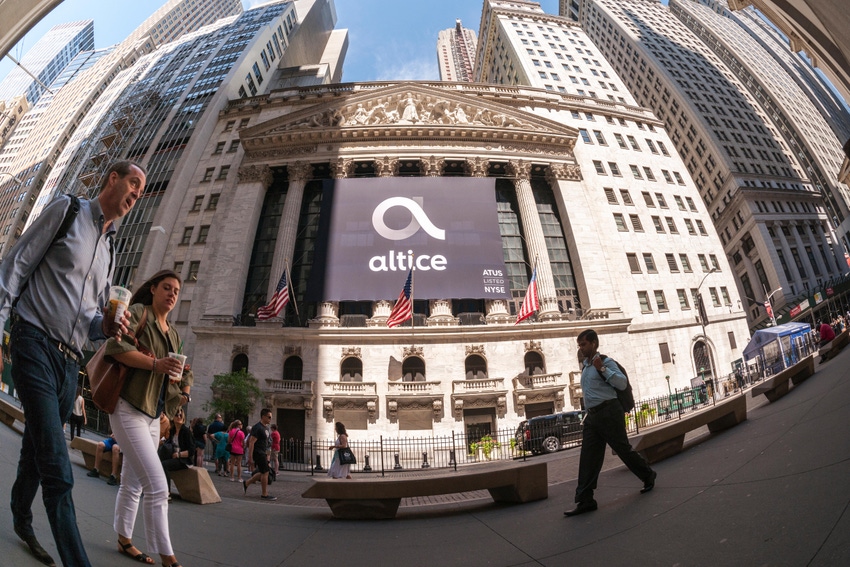Altice USA takes its 'medicine' as it cuts broadband prices
Amid a broader turnaround plan, Altice USA has slashed everyday 'rack rate' prices on broadband services. Analysts view it as a much-needed positive step but still have concerns.

Altice USA has enacted "rack rate" price cuts for fiber and cable broadband services, an adjustment on everyday, non-promotional pricing that analysts view as necessary as the operator looks to reverse subscriber losses and improve its overall health of its business.
As illustrated by a recent announcement to customers (via DSL Reports), the price cuts for existing Altice USA fiber-to-the-premises (FTTP) customers are "enormous" – ranging from 21% for its flagship 1-Gig tier to 36% for its lower-end 300 Mbit/s speed tier, MoffettNathanson found in its analysis (registration required) of the move.

(Source: MoffettNathanson and DSL Reports)
Those sizable cuts to Altice USA's non-promotional rack rates will be partially offset by an increase in the operator's "network enhancement fee," which reportedly is going up by $1.50 to $6 per month starting this month.
Altice USA, Moffett points out, is also lowering prices for new Optimum Cable customers who sign up on or after January 8. Under pricing for new cable broadband subs, Altice USA's 1-Gig (downstream) service, which is paired with upstream speeds up to 35 Mbit/s, will sell for $110 per month. Its introductory cable speed tier (100 Mbit/s down by 5 Mbit/s upstream) now goes for $50 per month.
The impact on cable is not expected to be as sizable as it is on the fiber side because new Altice USA cable customers "have almost always been brought in on promotional rates which are similar to the new rates," MoffettNathanson analyst Craig Moffett points out.
Fixing a years-old pricing problem
Broadly, the move aims to help undo "overzealous cost-cutting" paired by years of rack rate price increases that grew "totally out of touch with competitive realities" and contributed to ongoing broadband subscriber losses, Moffett explained. Amid those high rack rate prices, Altice USA was then forced to turn to big discounts to prevent customers from leaving.
"Operationally and financially, the result was… a mess," Moffett added.
Altice USA's rack rate pricing adjustment "is a step in the right direction," New Street Research analyst Jonathan Chaplin agreed in a research note. He also has long held that while Altice USA's promotional pricing has been competitive, its everyday rack rates have been too high.
Chaplin said he expects Altice USA to proactively move customers to higher broadband speed tiers that align their current ARPU with the new rack rate prices.
"For example, a customer paying $130 for 500 Mbps will be upgraded to 2 Gbps. This way, the customer gets a higher speed without paying more and Altice doesn't see a reduction in billing," Chaplin said. Though some customers could opt to move to lower prices after being moved to higher speed tiers, "we would expect this impact to be small," he added.
Altice USA has not shed much additional light on its pricing changes, but told Fierce Telecom that it is making adjustments to "reduce complexity, including reducing rate card pricing on many broadband tiers to provide a more transparent approach to promotional rates."
Concerns about ARPU and the gap among subs on promos and everyday pricing
But Chaplin still has some concerns, as he estimates that less than 10% of Altice USA subscribers are currently paying the company's rack rate. "Altice will continue to have a gap between promotional prices and rack rates, which we think is a mistake," he said.
Chaplin expects the network enhancement fee increase will provide a "small boost" to Altice USA's ARPU in 2024. The rack rate pricing reduction is "big," but he doesn't expect it to have a material impact on the company's overall ARPU.
Moffett, meanwhile, does have concerns that the moves could result in a material drop in ARPU while also lowering the company's EBITDA. While the "medicine won't taste very good" initially, the "payoff, of course, will be a much healthier and more sustainable business; lower churn and, eventually, better subscriber numbers."
UPDATE: Altice USA is less concerned about such an impact to the business. Speaking on the company's Q3 2023 call in December, CEO Denis Mathew referenced Altice USA's plans to revamp its pricing and packaging strategy, including a "speed gifting program" this year, starting with its fiber rate card. He noted that Altice USA doesn't expect to see a "notable impact on revenue" given that a small portion of the company's fiber subs are close to paying full rate. Customers on Altice USA's cable network will also move to new rate cards over time "through speed tier adjustments to match existing customer prices, preserving revenue."
More broadly, he said Altice USA expects that the new pricing and packaging strategy "will not have a negative impact on our go-forward revenue." The goal, Mathew added, "is to reduce bill-related call volume, churn and ARPU [average revenue per user] erosion, hold the gap between promo rates and rate card rates and remove offer and other bill-related complexities to provide clear, transparent pricing to our customers."
The company's pricing moves arrive as Mathew, the former Comcast exec who took the helm of Altice USA in October 2022, pushes ahead with a broader turnaround of the company. A key part of that plan is to stabilize the company's ARPU by pivoting away from steep promotions and rate events and to instead focus on speed upgrades and more transparency on pricing.
"We're in the early innings of this turnaround," Mathew said last month at an investor event.
About the Author(s)
You May Also Like












